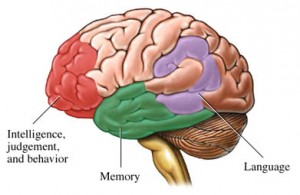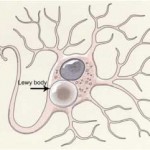Robin Williams Autopsy: No Drugs or Alcohol, But Lewy Body Dementia

The final autopsy report on the death of Robin Williams came in this week. According to the Marin County Coroner’s Office, the official cause of death is asphyxiation due to hanging, and the manner of death is suicide.
In addition, it was determined that there was no alcohol or illicit drugs detected in Mr. Williams body. Medications, at therapeutic concentrations, were detected.
Examination of Williams’ brain not only showed Parkinson’s disease, but there was also evidence of Lewy Body Dementia (see below). According to the coroner’s report, Williams had “a recent increase in paranoia” and was sleeping in a stepson’s bedroom because of insomnia and anxiety associated with Parkinson’s. The night before his death, Williams put several wristwatches into a sock and took them to someone’s house because he “was worried about them.”
Williams was diagnosed with Parkinson’s Disease in November 2013, after noticing tremors in his left hand and a slowing of movements in that hand.
Williams was cremated and that his ashed were scattered over the coast near his beloved San Francisco.
What is Lewy Body Dementia?
Dementia with Lewy bodies (DLB) is one of the most common types of progressive dementia.
According to the Lewy Body Dementia Association, DLB is not a rare disease. It affects an estimated 1.3 million individuals and their families in the United States.
 The main feature of DLB is a progressive decline in cognitive functioning. Cognition is a group of mental processes that includes attention, memory, producing and understanding language, solving problems, and making decisions.
The main feature of DLB is a progressive decline in cognitive functioning. Cognition is a group of mental processes that includes attention, memory, producing and understanding language, solving problems, and making decisions.
A patient must also have three additional defining features:
(1) Pronounced “fluctuations” in alertness and attention, such as frequent drowsiness, lethargy, lengthy periods of time spent staring into space, or disorganized speech
(2) Recurrent visual hallucinations
(3) Parkinsonian motor symptoms, such as rigidity and the loss of spontaneous movement.
 People may also suffer from depression.
People may also suffer from depression.
The symptoms of DLB are caused by the build-up of Lewy bodies.
Lewey bodies are accumulated bits of a protein called alpha-synuclein inside the nuclei of nerve cells. They are especially prominent in areas of the brain that control aspects of memory and motor control.
Researchers don’t know exactly why alpha-synuclein accumulates into Lewy bodies or how Lewy bodies cause the symptoms of DLB, but they do know that alpha-synuclein accumulation is also linked to Parkinson’s disease.
There is no cure for DLB. Treatments are aimed at controlling the cognitive, psychiatric, and motor symptoms of the disorder.
Like Alzheimer’s disease and Parkinson’s disease, DLB is a neurodegenerative disorder that results in progressive intellectual and functional deterioration. There are no known therapies to stop or slow the progression of DLB. Average survival after the time of diagnosis is similar to that in Alzheimer’s disease, about 8 years, with progressively increasing disability.
More information about Dementia.
More information about Alzeheimer’s Disease.
Resounding Health Casebook on Lewy Body Dementia



























0 comments